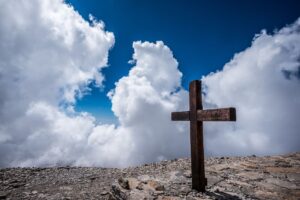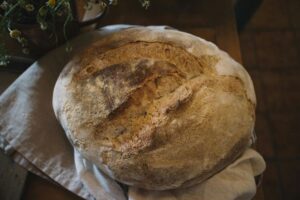Preparing sourdough is a slow process. It takes several days to reach the perfect condition for further use, as it is made from water and flour. Daily attention is required. People often say it needs to be “fed” in order to maintain its proper state and texture. Those who bake sourdough bread regularly know that the starter must be prepared before each baking session. This process takes time (it is ready in a few hours).
In the Bible, sourdough appears in the story of the Exodus. After the tenth plague (the death of every firstborn where the doorframes were not marked with blood – Exodus 11:4-7, 12:7, 12:12-13, 12:29), Pharaoh finally gave in and allowed the people chosen by God to leave Egypt for a new land and life (Exodus 12: 30-31)
In chronological order, the following events occurred as described in the Bible before the tenth plague took place:
- The Lord, through Moses, instructed His chosen people to select a one-year-old male lamb on the 10th day of the month and slaughter it in the evening on the 14th day. They were to take the lamb’s blood and smear it on the doorframes, as instructed. That same night, they were to roast the meat and eat it quickly, dressed and ready to leave – wearing belts around their waists, sandals on their feet, and staffs in their hands. Any leftovers were to be burned the following morning. (Exodus 12:3-11)
- Before the Exodus, the Lord commanded (at the same time as selecting the lamb, four days before the Exodus) that they should eat unleavened bread (Exodus 12:8) alongside the lamb’s meat. From that time onward, they were to commemorate the Exodus every year for seven days by eating only unleavened bread and removing all leavened products from their homes (Exodus 12:15-17).
- According to Exodus 12:29-39, at midnight, the Lord passed through the land of Egypt and struck down every firstborn, just as He had foretold. That very night, Pharaoh finally released the chosen people. Verse 39 states: “With the dough the Israelites had brought from Egypt, they baked loaves of unleavened bread. The dough was without yeast because they had been driven out of Egypt and did not have time to prepare food for themselves.”
Notice: they had four days to prepare for their departure, choosing and slaughtering the lamb. The haste was not unexpected – they had been instructed to eat unleavened bread. It’s possible that some doubted or lacked faith in God’s promise to deliver them.
They were told to eat unleavened bread, likely having enough time to prepare it if they had starter dough on hand, as was customary.
Thus, they ate unleavened bread not because they were rushed, but because it was commanded beforehand!
We find a contrasting teaching later in the Bible, from the time of Jesus
In Matthew 13:33, Jesus likened the Kingdom of Heaven to sourdough:
“The kingdom of heaven is like yeast that a woman took and mixed into about sixty pounds of flour until it worked all through the dough.” (See also Luke 13:21.)
Sourdough, as a symbol, holds deep significance. It requires long preparation and patient care to reach maturity, ready to fulfill its purpose of creating wholesome bread.
Similarly, human growth requires patience and nurturing. Just as sourdough transforms the bread from within, we too change through continuous development. Thoughts or feelings planted within us can grow over time, shaping us and influencing our lives and surroundings.
Sourdough also serves as a reminder of our past, traditions, and how people lived in earlier times.
If we neglect sourdough, we let go of a piece of our heritage, opting for modern solutions instead. For example, Paul Pitchford, in Healing with Whole Foods, explains that commercial yeast, unlike sourdough, is a relatively recent invention developed by French chemists a few centuries ago.
While commercial yeast lacks the deep-rooted traditions and spiritual essence of sourdough, sourdough symbolizes unity, fostering personal and communal growth.
Jesus likely emphasized this to remind us of our origins, connections, and shared responsibility to rediscover our path to God, our roots, and each other. However, Jesus also warned of the negative aspects of sourdough as a symbol. He cautioned:
“Be careful. Be on your guard against the yeast of the Pharisees and Sadducees.” (Matthew 16:6; Mark 8:15; Luke 12:1.)
In today’s world, there are many teachers and teachings, and it’s hard to determine which ones are authentic. However, this is one of the tasks we face as people living today. We can only choose wisely if we listen to our hearts, as it will always tell us the truth. It is through our hearts that we connect with God, and He speaks to us along this path.
Jesus continued his teaching: „Why don’t you understand that I wasn’t talking about bread?…” Then they understood that he wasn’t warning them about the yeast in bread, but about the teachings of the Pharisees and Sadducees. (Matthew 16:11-12)
Paul also wrote about this in Book of 1 Corinthians 5:6-8:
“Don’t you know that a little yeast leavens the whole batch of dough? Get rid of the old yeast, so that you may be a new unleavened batch—as you really are. For Christ, our Passover lamb, has been sacrificed. Therefore, let us keep the Festival, not with the old yeast, the yeast of malice and wickedness, but with the unleavened bread of sincerity and truth.”
Here, Paul talks about how the old teachings need to be set aside because people misunderstand them.









